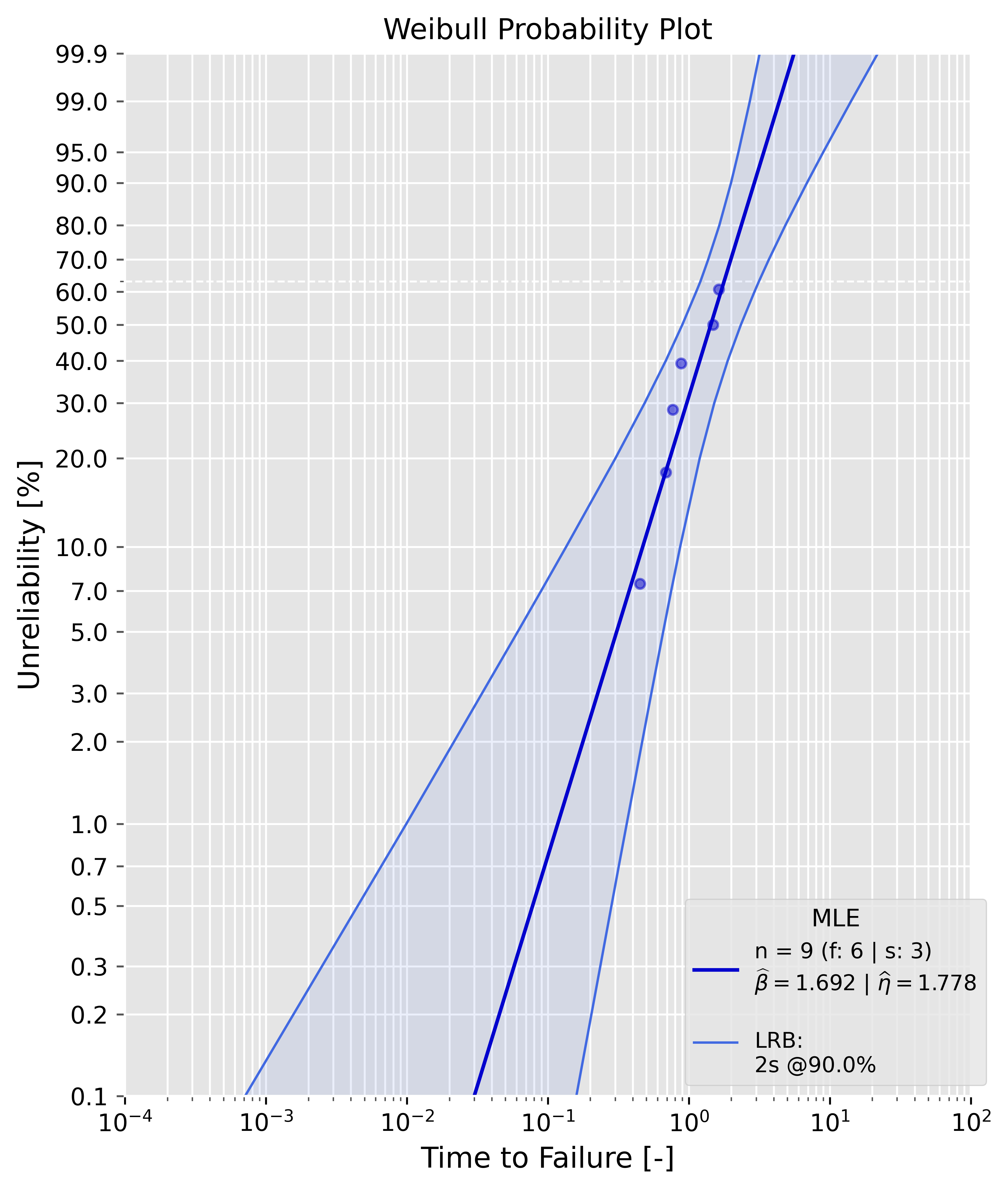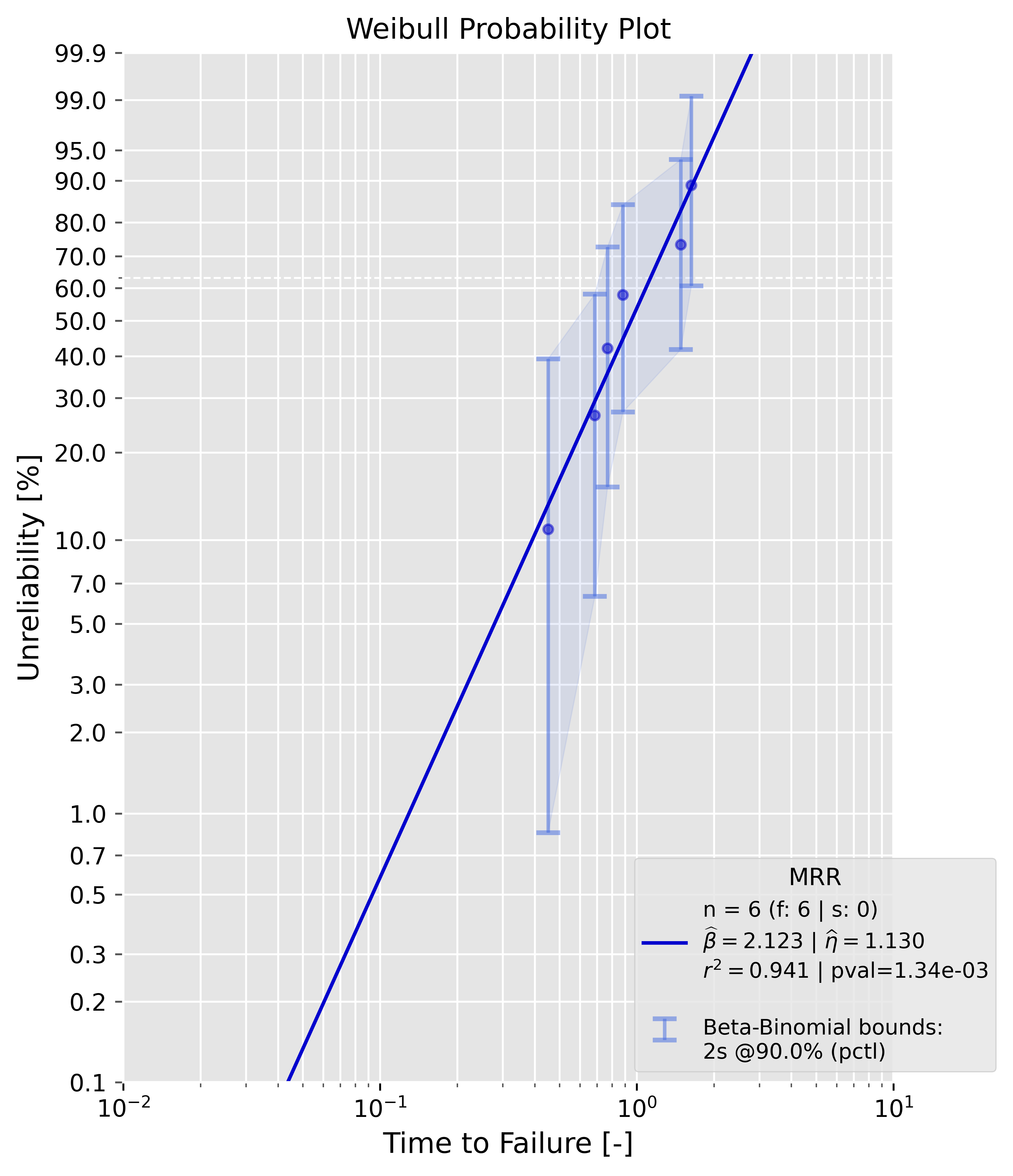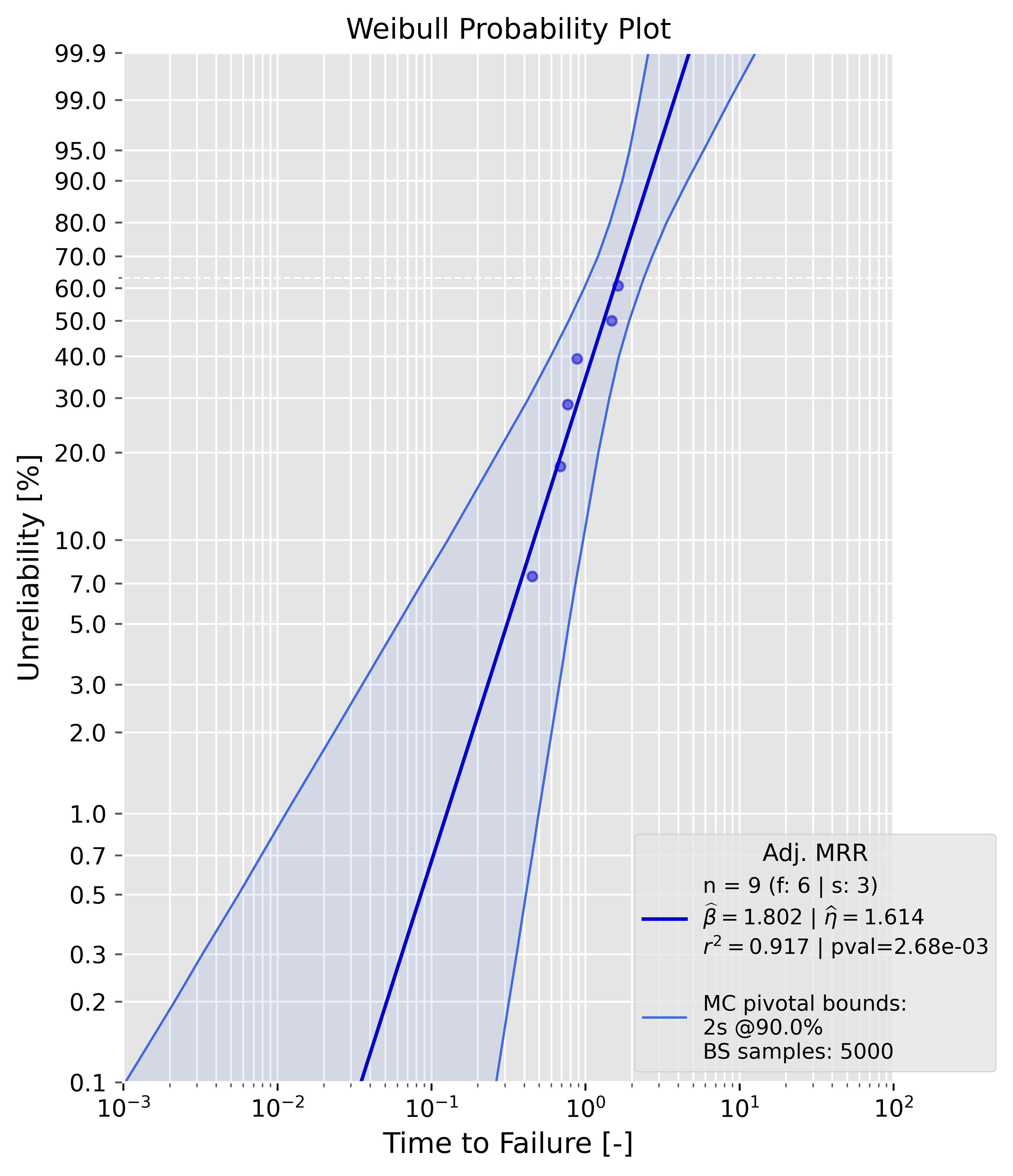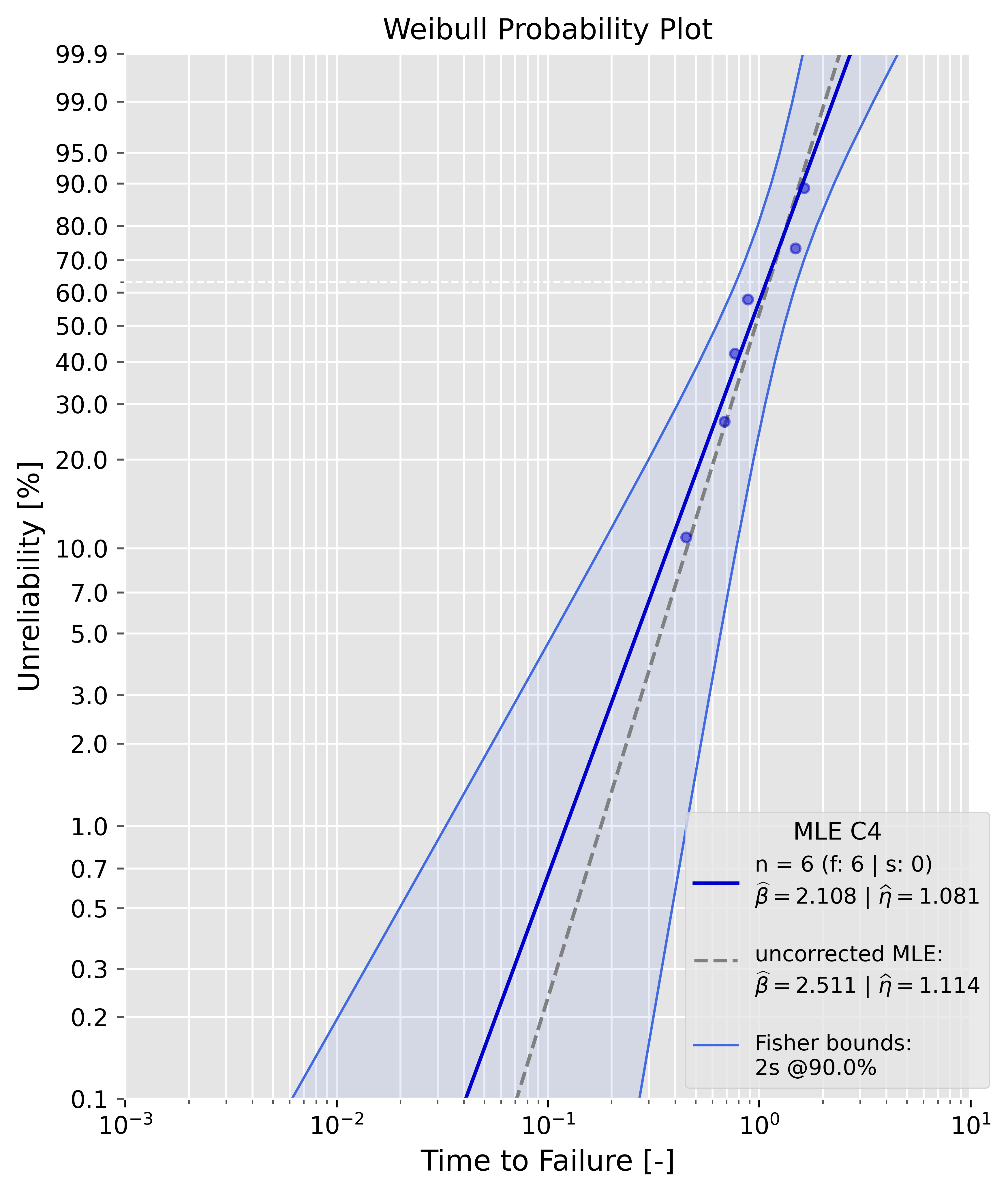Package gov.nih.mipav.model.algorithms
Class WeibullDistribution
- java.lang.Object
-
- gov.nih.mipav.model.algorithms.CeresSolver
-
- gov.nih.mipav.model.algorithms.WeibullDistribution
-
public class WeibullDistribution extends CeresSolver
-
-
Nested Class Summary
Nested Classes Modifier and Type Class Description (package private) classWeibullDistribution.Analysis(package private) classWeibullDistribution.ll_weib_beta_cen_r(package private) classWeibullDistribution.ll_weib_beta_uncen(package private) classWeibullDistribution.Pair<T,U>(package private) classWeibullDistribution.threeParameterFittingCostFunction(package private) classWeibullDistribution.twoParameterFittingCostFunction(package private) classWeibullDistribution.WeibullCostFunction2param(package private) classWeibullDistribution.WeibullCostFunction3param-
Nested classes/interfaces inherited from class gov.nih.mipav.model.algorithms.CeresSolver
CeresSolver.ArctanLoss, CeresSolver.ArmijoLineSearch, CeresSolver.AutoDiffCostFunction<CostFunctor>, CeresSolver.BadTestTerm, CeresSolver.BFGS, CeresSolver.Block, CeresSolver.BlockEvaluatePreparer, CeresSolver.BlockJacobianWriter, CeresSolver.BlockJacobiPreconditioner, CeresSolver.BlockRandomAccessDenseMatrix, CeresSolver.BlockRandomAccessDiagonalMatrix, CeresSolver.BlockRandomAccessMatrix, CeresSolver.BlockSparseMatrix, CeresSolver.BlockSparseMatrixRandomMatrixOptions, CeresSolver.CallbackReturnType, CeresSolver.CallStatistics, CeresSolver.CauchyLoss, CeresSolver.Cell, CeresSolver.CellInfo, CeresSolver.CellLessThan, CeresSolver.CgnrLinearOperator, CeresSolver.CgnrSolver, CeresSolver.Chunk, CeresSolver.ComposedLoss, CeresSolver.CompressedList, CeresSolver.CompressedRowBlockStructure, CeresSolver.CompressedRowJacobianWriter, CeresSolver.CompressedRowSparseMatrix, CeresSolver.ConjugateGradientsSolver, CeresSolver.Context, CeresSolver.CoordinateDescentMinimizer, CeresSolver.Corrector, CeresSolver.CostFunction, CeresSolver.CostFunctorExample, CeresSolver.CovarianceAlgorithmType, CeresSolver.CRSMatrix, CeresSolver.CurveFittingFunctorExample, CeresSolver.DenseJacobianWriter, CeresSolver.DenseLinearAlgebraLibraryType, CeresSolver.DenseNormalCholeskySolver, CeresSolver.DenseQRSolver, CeresSolver.DenseSchurComplementSolver, CeresSolver.DenseSparseMatrix, CeresSolver.DoglegStrategy, CeresSolver.DoglegType, CeresSolver.DumpFormatType, CeresSolver.DynamicCompressedRowJacobianFinalizer, CeresSolver.DynamicCompressedRowJacobianWriter, CeresSolver.DynamicCostFunction, CeresSolver.DynamicNumericDiffCostFunction<T>, CeresSolver.EasyCostFunction, CeresSolver.EasyFunctor, CeresSolver.EigenQuaternionParameterization, CeresSolver.EvaluateOptions, CeresSolver.EvaluateScratch, CeresSolver.EvaluationCallback, CeresSolver.Evaluator, CeresSolver.EvaluatorOptions, CeresSolver.EventLogger, CeresSolver.ExecutionSummary, CeresSolver.ExponentialCostFunction, CeresSolver.ExponentialFunctor, CeresSolver.FirstOrderFunction, CeresSolver.FunctionSample, CeresSolver.GoodTestTerm, CeresSolver.GradientChecker, CeresSolver.GradientCheckingCostFunction, CeresSolver.GradientCheckingIterationCallback, CeresSolver.GradientProblem, CeresSolver.GradientProblemEvaluator, CeresSolver.GradientProblemSolver, CeresSolver.GradientProblemSolverOptions, CeresSolver.GradientProblemSolverStateUpdatingCallback, CeresSolver.GradientProblemSolverSummary, CeresSolver.Graph<Vertex>, CeresSolver.HomogeneousVectorParameterization, CeresSolver.HuberLoss, CeresSolver.IdentityParameterization, CeresSolver.ImplicitSchurComplement, CeresSolver.indexValueItem<Vertex>, CeresSolver.IterationCallback, CeresSolver.IterationSummary, CeresSolver.IterativeSchurComplementSolver, CeresSolver.LBFGS, CeresSolver.LevenbergMarquardtStrategy, CeresSolver.LinearCostFunction, CeresSolver.LinearLeastSquaresProblem, CeresSolver.LinearOperator, CeresSolver.LinearSolver, CeresSolver.LinearSolverOptions, CeresSolver.LinearSolverPerSolveOptions, CeresSolver.LinearSolverSummary, CeresSolver.LinearSolverTerminationType, CeresSolver.LinearSolverType, CeresSolver.LineSearch, CeresSolver.LineSearchDirection, CeresSolver.LineSearchDirectionOptions, CeresSolver.LineSearchDirectionType, CeresSolver.LineSearchFunction, CeresSolver.LineSearchInterpolationType, CeresSolver.LineSearchMinimizer, CeresSolver.LineSearchOptions, CeresSolver.LineSearchPreprocessor, CeresSolver.LineSearchSummary, CeresSolver.LineSearchType, CeresSolver.LocalParameterization, CeresSolver.LoggingCallback, CeresSolver.LoggingType, CeresSolver.LossFunction, CeresSolver.LossFunctionWrapper, CeresSolver.LowRankInverseHessian, CeresSolver.Minimizer, CeresSolver.MinimizerOptions, CeresSolver.MinimizerType, CeresSolver.MyCostFunctor, CeresSolver.MyThreeParameterCostFunctor, CeresSolver.NonlinearConjugateGradient, CeresSolver.NonlinearConjugateGradientType, CeresSolver.NormalPrior, CeresSolver.NullJacobianFinalizer, CeresSolver.NumericDiffCostFunction<CostFunctor>, CeresSolver.NumericDiffMethodType, CeresSolver.NumericDiffOptions, CeresSolver.OnlyFillsOneOutputFunctor, CeresSolver.OrderedGroups<T>, CeresSolver.Ownership, CeresSolver.ParameterBlock, CeresSolver.PartitionedMatrixView, CeresSolver.Preconditioner, CeresSolver.PreconditionerOptions, CeresSolver.PreconditionerType, CeresSolver.PreprocessedProblem, CeresSolver.Preprocessor, CeresSolver.ProbeResults, CeresSolver.ProblemImpl, CeresSolver.ProblemOptions, CeresSolver.ProductParameterization, CeresSolver.Program, CeresSolver.ProgramEvaluator<EvaluatePreparer,JacobianWriter,JacobianFinalizer>, CeresSolver.QuaternionParameterization, CeresSolver.RandomizedCostFunction, CeresSolver.RandomizedFunctor, CeresSolver.ResidualBlock, CeresSolver.ScaledLoss, CeresSolver.SchurComplementSolver, CeresSolver.SchurEliminator, CeresSolver.SchurEliminatorBase, CeresSolver.SchurJacobiPreconditioner, CeresSolver.ScopedExecutionTimer, CeresSolver.ScratchEvaluatePreparer, CeresSolver.SizedCostFunction, CeresSolver.SizeTestingCostFunction, CeresSolver.SoftLOneLoss, CeresSolver.Solver, CeresSolver.SolverOptions, CeresSolver.SolverSummary, CeresSolver.SparseLinearAlgebraLibraryType, CeresSolver.SparseMatrix, CeresSolver.SparseMatrixPreconditionerWrapper, CeresSolver.StateUpdatingCallback, CeresSolver.SteepestDescent, CeresSolver.SubsetParameterization, CeresSolver.TerminationType, CeresSolver.TestTerm, CeresSolver.TolerantLoss, CeresSolver.TranscendentalCostFunction, CeresSolver.TranscendentalFunctor, CeresSolver.TripletSparseMatrix, CeresSolver.TripletSparseMatrixRandomMatrixOptions, CeresSolver.TrivialLoss, CeresSolver.TrustRegionMinimizer, CeresSolver.TrustRegionPreprocessor, CeresSolver.TrustRegionStepEvaluator, CeresSolver.TrustRegionStrategy, CeresSolver.TrustRegionStrategyOptions, CeresSolver.TrustRegionStrategyPerSolveOptions, CeresSolver.TrustRegionStrategySummary, CeresSolver.TrustRegionStrategyType, CeresSolver.TukeyLoss, CeresSolver.TypedLinearSolver<MatrixType>, CeresSolver.TypedPreconditioner<MatrixType>, CeresSolver.VertexDegreeLessThan<Vertex>, CeresSolver.VertexTotalOrdering<Vertex>, CeresSolver.VisibilityClusteringType, CeresSolver.WeightedGraph<Vertex>, CeresSolver.WolfeLineSearch
-
-
Field Summary
Fields Modifier and Type Field Description private double[]failuresprivate doublelocationprivate intnprivate doublescaleReference: Statistical Distributions Fourth Edition, Catherine Forbes, Merran Evans, Nicholas Hastings, and Brian Peacock, Chqapter 46, Weibull Distribution, pp. 193-201.private doubleshapeprivate double[]suspensionsprivate double[]tprivate ViewUserInterfaceUIprivate double[]w-
Fields inherited from class gov.nih.mipav.model.algorithms.CeresSolver
BAD_TEST_TERM_EXAMPLE, COST_FUNCTOR_EXAMPLE, CURVE_FITTING_EXAMPLE, curveFittingData, curveFittingObservations, default_relstep, DYNAMIC, EASY_COST_FUNCTION, EASY_FUNCTOR_EXAMPLE, epsilon, ERROR, EXPONENTIAL_COST_FUNCTION, EXPONENTIAL_FUNCTOR, FATAL, GOOD_TEST_TERM_EXAMPLE, INFO, LINEAR_COST_FUNCTION_EXAMPLE, m, MAX_LOG_LEVEL, MY_COST_FUNCTOR, MY_THREE_PARAMETER_COST_FUNCTOR, N0, ONLY_FILLS_ONE_OUTPUT_FUNCTOR, optionsValid, RANDOMIZED_COST_FUNCTION, RANDOMIZED_FUNCTOR, SIZE_TESTING_COST_FUNCTION, svd, TEST_TERM_EXAMPLE, testCase, testMode, TRANSCENDENTAL_COST_FUNCTION, TRANSCENDENTAL_FUNCTOR, WARNING
-
-
Constructor Summary
Constructors Constructor Description WeibullDistribution()WeibullDistribution(double scale, double shape, double location, double[] w, double[] t)
-
Method Summary
All Methods Instance Methods Concrete Methods Modifier and Type Method Description booleanfitToExternalFunction(double[] x, double[] residuals, double[][] jacobian)voidgenerateRandomWeibull2param()voidgenerateRandomWeibull3param()voidgenerateSequentialWeibull2param()voidgenerateSequentialWeibull3param()voidintialThreeParameterApproximation(double[] scale0, double[] shape0, double[] location0)voidtest_mle()Maximum likelihood estimation (MLE):** ```python from predictr import Analysis prototype_a = Analysis(...) # create an instance prototype_a.mle() # use instance methods ``` Median Rank Regression (MRR)** ```python from predictr import Analysis prototype_a = Analysis(...) # create an instance prototype_a.mrr() # use instance methods ``` ### Bias-correction methods Since parameter estimation methods are only asymptotically unbiased (sample sizes -> "infinity"), bias-correction methods are useful when you have only a few failures.voidtest_mrr()voidtestInitialThreeParameterApproximation()voidtestRandomWeibull()voidtestSequentialWeibull2param()voidtestSequentialWeibull3param()-
Methods inherited from class gov.nih.mipav.model.algorithms.CeresSolver
AppendArrayToString, ApplyOrdering, BuildResidualLayout, ComputeHouseholderVector, ComputeRecursiveIndependentSetOrdering, ComputeSchurOrdering, ComputeStableSchurOrdering, copyFunctionSample, Create, Create, Create, Create, Create, Create, Create, CreateDiagonalMatrix, CreateEvaluatorScratch, CreateGradientCheckingCostFunction, CreateGradientCheckingProblemImpl, CreateHessianGraph, CreateLinearLeastSquaresProblemFromId, CreateOrdering, createPartitionedMatrixView, CreatePreprocessor, CreateRandomMatrix, CreateRandomMatrix, createSchurEliminatorBase, CreateSparseDiagonalMatrix, DetectStructure, DifferentiatePolynomial, DumpLinearLeastSquaresProblem, DumpLinearLeastSquaresProblemToConsole, DumpLinearLeastSquaresProblemToTextFile, EigenQuaternionProduct, EvaluateCostFunction, EvaluateJacobianColumn, EvaluateJacobianForParameterBlock, EvaluateJacobianForParameterBlock, EvaluatePolynomial, EvaluateRiddersJacobianColumn, ExpectClose, FindInterpolatingPolynomial, FindInvalidValue, FindLinearPolynomialRoots, FindPolynomialRoots, FindQuadraticPolynomialRoots, FindWithDefault, FindWithDefault, GetBestSchurTemplateSpecialization, GradientProblemSolverOptionsToSolverOptions, IndependentSetOrdering, InvalidateArray, InvalidateArray, InvalidateArray, InvalidateArray, InvertPSDMatrix, IsArrayValid, IsArrayValid, IsArrayValid, IsArrayValid, IsClose, IsOrderingValid, IsSchurType, IsSolutionUsable, IsSolutionUsable, LexicographicallyOrderResidualBlocks, LinearLeastSquaresProblem0, LinearLeastSquaresProblem1, LinearLeastSquaresProblem2, LinearLeastSquaresProblem3, LinearLeastSquaresProblem4, LinearSolverForZeroEBlocks, LinearSolverTypeToString, LineSearchDirectionTypeToString, LineSearchInterpolationTypeToString, LineSearchTypeToString, MatrixMatrixMultiply, MatrixMatrixMultiply, MatrixMatrixMultiply, MatrixMatrixMultiply, MatrixTransposeMatrixMultiply, MatrixTransposeVectorMultiply, MatrixVectorMultiply, MaybeReorderSchurComplementColumnsUsingEigen, MaybeReorderSchurComplementColumnsUsingSuiteSparse, Minimize, MinimizeInterpolatingPolynomial, MinimizePolynomial, MinParameterBlock, NonlinearConjugateGradientTypeToString, operator, PostSolveSummarize, PreconditionerForZeroEBlocks, PreconditionerTypeToString, QuaternionProduct, RandDouble, RandDouble, RandNormal, RemoveLeadingZeros, ReorderProgramForSchurTypeLinearSolver, RunCallbacks, SchurStructureToString, SetSummaryFinalCost, SetSummaryFinalCost, SetupCommonMinimizerOptions, Solve, Solve, StableIndependentSetOrdering, SummarizeReducedProgram, swap, TerminationTypeToString, TransposeForCompressedRowSparseStructure, Uniform, WriteArrayToFileOrDie, WriteStringToFileOrDie
-
-
-
-
Field Detail
-
scale
private double scale
Reference: Statistical Distributions Fourth Edition, Catherine Forbes, Merran Evans, Nicholas Hastings, and Brian Peacock, Chqapter 46, Weibull Distribution, pp. 193-201. Variable 0 =< x < infinity scale parameter > 0 is the characteristic life shape parameter > 0 0 < location <= t[i] for all i pdf: (shape * t**(shape-1)/(scale ** shape)) * exp(-(t/scale)**shape) for t > 0 for 2 parameters pdf: 0 for t <= 0 for 2 parameters for 2 parameters pdf: (shape * (t-location)**(shape-1)/(scale ** shape)) * exp(-((t-location)/scale)**shape) for t > location for 3 parameters pdf: 0 for t <= location for 3 parameters Random number generator: scale, shape can be generated from those of the rectangular unit variate R using the relationship: W: scale, shape ~ scale * pow((-log R),(1/shape) By the method of maximum likelihood the estimators scaleML, shapeML are the solution of the simultaneous equations: scaleML = [(1/n)*(sum from i = 1 to n of xi**shapeML)]**(1/shapeML) shapeML = n/denom denom = (1/scaleML)*(sum from i = 1 to N of (xi**shapeML)*log(xi)) - (sum from i = 1 to n of log(xi)) The three parameter cumulative distribution function is: F(t; location, shape, scale) = 1 - exp(-((t-location)/scale)**shape) for t > location = 0 for t < location This file contains code ported from the file predictr.py by Tamer Tevetoglu. # predictr - Predict the Reliability predictr: predict + reliability, in other words: A tool to predict the reliability.
The aim of this package is to provide state of the art tools for all kinds of Weibull analyses.
The license follows: MIT License Copyright (c) 2020-present Tamer Tevetoglu Permission is hereby granted, free of charge, to any person obtaining a copy of this software and associated documentation files (the "Software"), to deal in the Software without restriction, including without limitation the rights to use, copy, modify, merge, publish, distribute, sublicense, and/or sell copies of the Software, and to permit persons to whom the Software is furnished to do so, subject to the following conditions: The above copyright notice and this permission notice shall be included in all copies or substantial portions of the Software. THE SOFTWARE IS PROVIDED "AS IS", WITHOUT WARRANTY OF ANY KIND, EXPRESS OR IMPLIED, INCLUDING BUT NOT LIMITED TO THE WARRANTIES OF MERCHANTABILITY, FITNESS FOR A PARTICULAR PURPOSE AND NONINFRINGEMENT. IN NO EVENT SHALL THE AUTHORS OR COPYRIGHT HOLDERS BE LIABLE FOR ANY CLAIM, DAMAGES OR OTHER LIABILITY, WHETHER IN AN ACTION OF CONTRACT, TORT OR OTHERWISE, ARISING FROM, OUT OF OR IN CONNECTION WITH THE SOFTWARE OR THE USE OR OTHER DEALINGS IN THE SOFTWARE. You can cite predictr in your publication or research work using the Digital Object Identifier (DOI): 10.5281/zenodo.4614034 ## BibTeX
-
shape
private double shape
-
location
private double location
-
w
private double[] w
-
t
private double[] t
-
n
private int n
-
UI
private ViewUserInterface UI
-
failures
private double[] failures
-
suspensions
private double[] suspensions
-
-
Method Detail
-
generateRandomWeibull2param
public void generateRandomWeibull2param()
-
generateRandomWeibull3param
public void generateRandomWeibull3param()
-
generateSequentialWeibull2param
public void generateSequentialWeibull2param()
-
generateSequentialWeibull3param
public void generateSequentialWeibull3param()
-
testSequentialWeibull2param
public void testSequentialWeibull2param()
-
testSequentialWeibull3param
public void testSequentialWeibull3param()
-
testInitialThreeParameterApproximation
public void testInitialThreeParameterApproximation()
-
intialThreeParameterApproximation
public void intialThreeParameterApproximation(double[] scale0, double[] shape0, double[] location0)
-
testRandomWeibull
public void testRandomWeibull()
-
fitToExternalFunction
public boolean fitToExternalFunction(double[] x, double[] residuals, double[][] jacobian)- Specified by:
fitToExternalFunctionin classCeresSolver
-
test_mle
public void test_mle()
Maximum likelihood estimation (MLE):** ```python from predictr import Analysis prototype_a = Analysis(...) # create an instance prototype_a.mle() # use instance methods ``` Median Rank Regression (MRR)** ```python from predictr import Analysis prototype_a = Analysis(...) # create an instance prototype_a.mrr() # use instance methods ``` ### Bias-correction methods Since parameter estimation methods are only asymptotically unbiased (sample sizes -> "infinity"), bias-correction methods are useful when you have only a few failures. These methods correct the Weibull shape and scale parameter. The following table provides possible configurations. Bias-corrections for mrr() are not supported, yet.
| Bias-correction method | mle() | mrr() | argument value | config. | statistic | |-------------------------------------|:-----:|:-----:|:--------------:|:-------:|:--------------------------------:| | C4 aka 'reduced bias adjustment' | x | - | 'c4' | - | - | | Hirose and Ross method | x | - | 'hrbu' | - | - | | Non-parametric Bootstrap correction | x | - | 'np_bs' | bs_size | 'mean', 'median', 'trimmed_mean' | | Parametric Bootstrap correction | x | - | 'p_bs' | bs_size | 'mean', 'median', 'trimmed_mean' | ### Confidence bounds methods Analysis supports nearly all state of the art confidence bounds methods. | confidence bounds | mle() | mrr() | uncensored data | censored data | bounds_type | argument value | |---------------------------------|:-----:|:-----:|:---------------:|:-------------:|:------------------:|:--------------:| | Beta-Binomial Bounds | - | x | x | x | '2s', '1sl', '1su' | 'bbb' | | Monte-Carlo Pivotal Bounds | - | x | x | x | '2s', '1sl', '1su' | 'mcpb' | | Non-Parametric Bootstrap Bounds | x | x | x | x | '2s', '1sl', '1su' | 'npbb' | | Parametric Bootstrap Bounds | x | x | x | x | '2s', '1sl', '1su' | 'pbb' | | Fisher Bounds | x | - | x | x | '2s', '1sl', '1su' | 'fb' | | Likelihood Ratio Bounds | x | - | x | x | '2s', '1sl', '1su' | 'lrb' | Important**: - mle() and mrr() support only specific confidence bounds methods. For instance, you can't use Beta-Binomial Bounds with mle(). This will also raise an error. Use the table above to check, whether a combination of parameter estimation and confidence bounds method is supported. - '2s': two-sided confidence bounds, '1su': upper confidence bounds, '1sl': lower confidence bounds. If Beta-Binomial Bounds are used, the lower bound represents the lower percentile bound at a specific time ((pctl) is added in the plot legend). If Fisher Bounds are used, the lower bound represents the lower time bound at a specific percentile. ### Examples #### Maximum Likelihood Estimation (MLE) ##### Uncensored sample Example: ```python failures = [0.4508831, 0.68564703, 0.76826143, 0.88231395, 1.48287253, 1.62876357] prototype_a = Analysis(df=failures, bounds='fb',show=True) prototype_a.mle() ``` {: width="500" } ##### Censored sample Example: ```python failures = [0.4508831, 0.68564703, 0.76826143, 0.88231395, 1.48287253, 1.62876357] suspensions = [1.9, 2.0, 2.0] prototype_a = Analysis(df=failures, ds=suspensions, bounds='lrb',show=True) prototype_a.mle() ``` {: width="500" } #### Median Rank Regression (MRR) ##### Uncensored sample Example: ```python failures = [0.4508831, 0.68564703, 0.76826143, 0.88231395, 1.48287253, 1.62876357] prototype_a = Analysis(df=failures, bounds='bbb',show=True) prototype_a.mrr() ``` {: width="500" } ##### Censored sample Example: ```python failures = [0.4508831, 0.68564703, 0.76826143, 0.88231395, 1.48287253, 1.62876357] suspensions = [1.9, 2.0, 2.0] prototype_a = Analysis(df=failures, ds=suspensions, bounds='mcpb',show=True) prototype_a.mrr() ##### Censored sample Example: ```python failures = [0.4508831, 0.68564703, 0.76826143, 0.88231395, 1.48287253, 1.62876357] suspensions = [1.9, 2.0, 2.0] prototype_a = Analysis(df=failures, ds=suspensions, bounds='mcpb',show=True) prototype_a.mrr() ``` {: width="500" } #### Bias-corrections As already mentioned, only mle() support bias-corrections. The samples in these examples are drawn from a two-parameter Weibull distribution with a shape parameter of 2.0 and a scale parameter of 1.0. ##### Uncensored sample It is appearent that the estimates of beta and eta are now closer to the ground truth values. The dotted grey line in the plot is the "biased" MLE line, the bia-corrected line is blue. The legend contains all needed information. ```python failures = [0.4508831, 0.68564703, 0.76826143, 0.88231395, 1.48287253, 1.62876357] prototype_a = Analysis(df=failures, bounds='fb', show=True, bcm='c4') prototype_a.mle() ``` {: width="500" } The estimates can for the Weibull parameters can be compared directly, since they are available as attributes ```python print(f'biased beta: {prototype_a.beta:4f} --> bias-corrected beta: {prototype_a.beta_c4:4f}') >>> biased beta: 2.511134 --> bias-corrected beta: 2.108248 ``` ##### Censored sample The data is type II right-censored. ```python failures = [0.38760099164906514, 0.5867052007217437, 0.5878056753744406, 0.602290402929083, 0.6754829518358306, 0.7520219855697948] suspensions = [0.7520219855697948, 0.7520219855697948] prototype_a = Analysis(df=failures, ds=suspensions, bounds='lrb', show=True, bcm='hrbu') prototype_a.mle()
-
test_mrr
public void test_mrr()
-
-